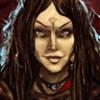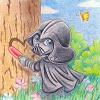
Of Elves and Magic
#1

Posted 01 December 2005 - 09:53 PM
Elves are beings with close ties to magic - beings partially made of magic, some say. How are elves tied to the Weave? Does Corellon control Elven Magic on Faerun, or does the human goddess Mystra do so? Although I am only one of many sages pondering these mysteries, I have some conclusions which may help those struggling with the issue.
The Weave and Mystra
The Weave is the mantle of magic that envelops the world of Faerun. I compare it to a type of loosely-woven cloth, made of threads of magical power. When a mage or a cleric casts a spell or a blessing, he essentially gathers some of these threads of power and weaves them into his spell.
What is truly unique about the Weave is that it has a mind, a personality. The personification of the mantle of magic is a human woman, currently known by the name of Mystra. (Most Faerunians don't know this, but the current Mystra is the third known incarnation of the Weave. In the Year of The Sundered Webs, Mystryl was destroyed by a Netherese Mage and replaced by Mystra. The Year of Shadows, otherwise known as the Time of Troubles, saw the destruction of Mystra, replaced by the mortal Midnight who held great magical potential, and accepted the same name as her predecessor.) No matter what her form and name, Mystra is the embodiment of the Weave, the personification of the power that guards and permits magic in the Realms.
If she is more a mystical force than a traditional deity, why does she take on the appearance of a human woman? Why not an elven woman? Or a dragon, or one of the so-called 'Creator Races' that sages believe may have preceded all natural life on Faerun? The answer is that maybe she did.
The first major tearing of the Weave took place deep in the history of Faerun before the First Flowering of The People (24,000 DR). In the Sundering, elves called upon a vast portion of the Weave and all the Seldarine to pull a little piece of Aryvandor down to Faerun. The results of this spell not only created the elven isle of Evermeet, but also tore the one continent of the world into pieces. If it wreaked so much destruction on the realm, imagine what it did to the Weave!
In the magic of the Sundering, the souls of almost all the spellcasters fused with the Weave, then were torn from the lifeless bodies by the uncontrollable magical force unleashed upon the land. Corellon and the Seldarine pulled those souls and their threads of magic into the Tree of Souls, and to this day High Magic is possible in its presence.
I believe that on that confused day with a hundred souls fused together in casting, the Weave gained its first awareness. Each person opened the Weave to love, fear, pride, joy, wisdome, and recognition of the immense and deadly power the Weave is capable of. Imagine a newly awoken entity being torn apart - the sensation must have been like a person losing a limb! Any being would seek a way to protect itself from such damage again. What better way to protect itself than to use one of the kind who injured it, creating an image with which to guard itself and oversee those using the magical power. I believe that the image the Weave took was one of the elven mages present in the casting, one moon-elf mage named 'Mystryl.' It is possible that her essence is not part of the Tree of Souls, but instead remained with the Weave.
What is definitely known is that humans were not casting magic when the Sundering took place. It wasn't until several millennia later (-3835 DR) that the elves of Eaerlann discovered the settlement of Netheril and began developing their use of the Art. It is probable that Mystryl had a hand in the development of the human magical abilities. Why focus all her energies on elves, who are rather haughty in their knowledge of magic, when there was a whole new community to encourage, one that would truly recognize and appreciate her efforts?
This would certainly explain why Mystryl rarely took a humanoid visage, choosing instead a blue and white glow, or a variety of magical animals (as described on pgs. 49-50 of the Netheril boxed set). When she was depicted, it was as a vaguely female humanoid shape composed entirely of prismatic-hued will-o'-wisps. Her clergy described her as "flirtatious and profound, flighty and persistent, light-hearted and deadly serious. Her moods and state-of-mind varied from moment to moment, but she generally tried to do what she thought was right." These are the very words non-elves use to describe the elves as a whole! In any case, the humans accepted her as their goddess of magic.
One of these humans eventually brought the downfall of Mystryl. Many centuries of magic eventually warped the Netherese, and a mage strove for godhood. In his magic, he conquered the persona of the Weave and pulled all magic from the world for a time. Before her passing, Mystryl imbued her power in a human, who assumed the role of Mystra, a human goddess of magic, as well as the guardian and persona of the Weave.
The Weave suffered additional damage in this Year of the Sundered Webs (-339 DR), and more of the High Magics were torn from Faerun. Mystra stripped the humans of their highest magical powers partly as punishment, partly to safeguard the ripped remainder of the Weave.
Mystra has great control over the Weave, whether the peoples of the Realms recognize her as such or not. Even in the human regions of Unther and Mulhorandi, where she is unnamed and unspoken of, she safeguards the Weave and oversees the deities of the spellcasters. Those deities such as Thoth, Velsharoon, and Azuth must still recognize the role that Mystra commands in Faerun magic.
Mystra and Corellon
In Elven tradition, there is one who embodies all that elves hold dear: Corellon Larethian, Creator of Elves, the Protector, the patron of art, swordplay, and elven magic. Many mages invoke the name of Corellon when practicing the Art. Yet elven mages also call out the name of Mystra, have done so since Elminster walked among elves. Is this an affront to the Seldarine? Absolutely not. Although most elven societies frown on any elf worshipping a human deity, elves recognize her presence in the power they harness. That presence is not in the form of any particular race. She IS the Weave, and therefore the power required to cast their elven magics.
So what is the difference between Corellon's governing of Elven magic, and Mystra's control of the Weave? There are several, yet the nature of each requires the two to work hand-in-hand.
First of all, elves do exist on worlds other than Faerun. Wherever they are, Corellon guides their spellcasting. But if they do not have access to a magical power source, their casting is useless. If an elf came to a planet where there was no magic whatsoever, all the calls to Corellon would be in vain.
On Faerun, that source of magical power is Mystra. If the Weave ceased to exist, there would be no magic of any kind. Not human, not gnomish, not elven. This was proven at the Fall of Netheril. Hence, Mystra is important to ALL magic-using peoples of Toril, whether they know her or not.
Before exploring Corellon's part in the Weave, it is important to realize that every elf - no matter which world they live in - has a part of the elven spiritual homeland within him. This homeland, Aryvandor, is the home of the Seldarine, the pantheon of elven deities. Every elf makes the journey to Aryvandor when his time on whichever world he lives in has ended. The place is living magic. In order to find their way to Aryvandor when his time comes, an elf has some of that magical essence of the homeland in his soul. Does this mean elves can innately cast spells? No. Does it mean that all elves have a natural talent for magic? Again, no, although magic is a passion with several elves.
Then what does this piece of Aryvandor do for elves, then?
It is what grants them a natural life several centuries long. It is what enables them to enter the unique trance called Reverie. When in -10,000 DR the dark elves were driven from the surface by Corellon's power, he ripped that part of Aryvandor from their beings. As a result, their lifespans are not as long as surface elves, and they do not enter the Reverie.
Yet, a look at the Chosen of Mystra show a strange similarity - amazing long life. No need for sleep. It is also said that half elves, on their own unable to experience reverie, can enter that state if they have an exceptionally strong tie to the weave. Both an elf's connection to Aryvandor and a person's exceptional connection with the Weave grant the same gifts. How is this possible? Is it merely coincidence?
Again, I believe the answer lies in the Sundering, and in the creation of the Tree of Souls. Elves tore the Weave apart. Elven casters became infused in the Weave. Corellon collected those souls AND the threads of the Weave they fused to, and with it created the Tree of Souls. The newly awakened Weave must have protested at this partial destruction and demanded amends. Would the Seldarine have the power to recreate the Weave? I believe not, but they would be able to offer the Weave something in return - access to the magical essence of Aryvandor.
Eric Boyd wrote on the List that he and Steven Schend theorized that "Elven High Magic is actually a synthesis of the proto-mass of Aryvandor and the Weave." Elves can call on this because of the magic in their souls from Aryvandor, and mesh it with the Weave. Yet Mystra must be involved if Faerun's elves attempt to call on High Magic today. Mystra could deny access to High Magic? yet if she did so, Corellon would surely revoke Mystra's access to Aryvandor magic. Therefore, Mystra and Corellon have a friendly balance of power between them. And Mystra is able to grant some of the benefits the Aryvandor magic bestows on non-elves via the Weave.
Freedom cannot be equated with goodness, virtue, or perfection. Freedom has its own unique self-contained nature; freedom is freedom ? not universal goodness. Any confusion or deliberate equalization of freedom with goodness and excellence is in itself negation of freedom, and acceptance of the path of restraint and enforcement.
Nikolai Berdyaev - Christian Existentialist, Philosopher of Freedom.
The Longer Road mod
Redemption mod
Bitter Grey Ashes
#2

Posted 01 December 2005 - 11:08 PM
IWD NPC, Xan, The Sellswords, Back to Brynnlaw, Assassinations, Dungeon Crawl, Reunion, Branwen, Coran, Tiax, Xan BG1 Friendship
BG1 NPC, Romantic Encounters














